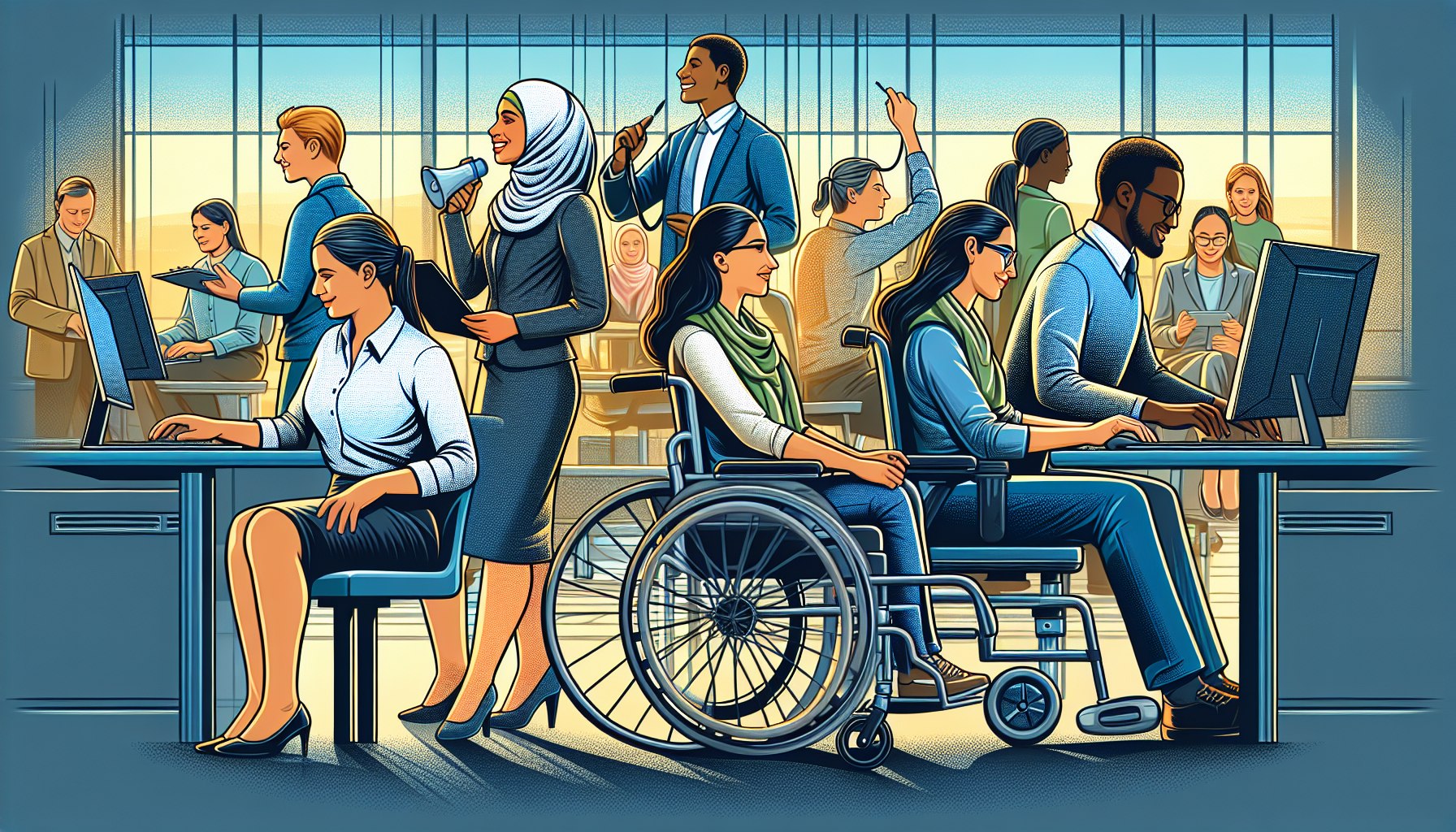Have you ever wondered what discrimination in the workplace truly looks like? This article dives into real-life examples of discrimination in the workplace, revealing the harsh realities of racial, gender, and disability discrimination that professionals confront. These stories not only highlight the issue but also provide context for the ongoing struggle against workplace inequity.
Key Takeaways
-
Discrimination in the workplace encompasses a range of issues including racial, gender identity, sex, disability, age, national origin, and religious discrimination, creating unfair treatment and hostile environments for affected employees.
-
Sexual harassment is a widespread problem in the workplace, with two main forms: quid pro quo and a hostile work environment, both of which are harmful and illegal, requiring appropriate reporting and resolution mechanisms.
-
The legal framework against discrimination, enforced by the Equal Employment Opportunity Commission (EEOC), provides protection for employees and offers a formal process for reporting discrimination, with measures to combat retaliation against those who file complaints.
Unpacking Examples of Workplace Discrimination

We will start by examining real-life instances of discrimination, presented in their raw and unsettling forms. These stories shed light on the various faces of discrimination, from racial prejudice to gender identity bias and disability discrimination. As we explore these cases, we must bear in mind that these are not isolated incidents but rather indicative of a systemic issue that plagues workplaces across the globe.
Next, we will scrutinize these forms of discrimination, starting with racial discrimination. How does it manifest in the workplace? And what are the impacts on the victims and their work environment?
Racial Discrimination: More Than Just Words
Racial discrimination is more than just derogatory words or slurs; it’s a harmful practice that undermines the dignity of individuals and creates a hostile work environment. Instances of biased disciplinary practices give us a glimpse of the insidious nature of this issue. For example, there have been cases where Black and Hispanic employees were disciplined for violations, while their Caucasian counterparts committing similar infractions were not reprimanded.
Some racially discriminatory practices have escalated to disturbing levels, with offensive symbols such as nooses displayed and particularly egregious derogatory language targeted at employees of color. These practices go beyond causing discomfort and distress, potentially leading to psychological harm and damaging the overall working environment.
Gender Identity and Sex Discrimination: Barriers to Equality
The obstacles to equality encompass gender identity, sexual orientation, and sex discrimination, another pervasive form of bias in the workplace. It occurs when men and women who are similarly situated are treated differently based on their gender, which includes mistreating someone because of their gender identity.
This form of discrimination often goes unnoticed as it might not be as blatant as racial discrimination. However, it is just as damaging, affecting the individual’s work performance, professional growth, and overall job satisfaction.
Disability Discrimination: The Struggle for Accommodation
Securing adequate accommodations is a notable struggle for employees with disabilities. Despite laws mandating reasonable accommodations, many employees still face outright refusal that hampers their job performance. This refusal can take many forms, ranging from not providing ergonomic workstations to denying flexible work schedules or necessary assistive technologies.
Moreover, employees with disabilities often face barriers in training programs, further limiting their professional growth. These discriminatory practices, including employment discrimination, contribute to higher unemployment and underemployment rates among people with disabilities, impacting their overall economic stability.
Recognizing Subtle Forms of Discrimination at Work
While some types of discrimination discussed earlier are overt, there exist other, subtler forms that are equally harmful. These include age discrimination, national origin discrimination, and religious discrimination. These forms of discrimination are often overlooked, yet their impact can be just as damaging, creating an environment where employees are treated unfairly based on their age, national origin, or religious beliefs.
Some examples of discrimination include:
-
Age discrimination, which can result in forced retirement and exclusion from opportunities
-
National origin discrimination, which can manifest in biases against accent, ethnicity, or physical appearance
-
Religious discrimination, which can lead to denial of reasonable accommodations for religious practices
These forms of discrimination may not always be as apparent as racial or sex discrimination, but they can have severe impacts.
Age Discrimination: Not Just a Number
Age discrimination occurs when individuals over the age of 40 receive differential treatment compared to their younger colleagues in various employment aspects, including:
-
Hiring
-
Firing
-
Promotion
-
Job assignments
-
Training
Older employees are sometimes subjected to forced or encouraged retirement through financial incentives offered by companies, leading to a gradual reduction in their responsibilities.
In the workplace, older workers often face exclusion from important meetings, marginalization in decision-making processes, and are given non-challenging tasks. There is also a significant inequality in the provision of job-related training opportunities for older employees, with fewer older adults participating in such training compared to their younger counterparts.
National Origin Discrimination: Beyond Birthplace
National origin discrimination, an understated form of bias, goes beyond just a person’s place of birth. It encompasses differential treatment of workers or applicants based on their country or region of origin, which can include biases against their accent, ethnicity, or physical appearance.
This form of discrimination is not just about where one is born, but encompasses a wider range of factors linked to one’s heritage. It’s a form of bias that can manifest in various ways, from negative comments about one’s accent to prejudices based on physical features associated with a particular ethnicity or country.
Religious Discrimination: A Question of Beliefs
Religious discrimination represents another understated but significant form of bias in the workplace. Employees may face denial of reasonable accommodations for their religious practices, such as:
-
flexible scheduling
-
voluntary substitutions
-
job reassignments
-
transfers
Sometimes, employers may claim undue hardship as a reason for denying these accommodations. However, undue hardship can only be claimed when the employee’s request involves significant expense beyond administrative costs or infringes on other employees’ job rights or benefits.
Can an employer ask about your religious beliefs: Understanding Religious Discrimination in the Workplace
Sexual Harassment: A Pervasive Issue
Sexual harassment is a widespread problem in numerous workplaces, often casting a shadow over the employees’ sense of safety and job satisfaction. Defined by unwanted and unwelcome advances of a sexual nature, it can take the form of inappropriate comments, unwelcome advances, and even actions that contribute to a hostile work environment.
Sexual harassment presents itself in a range of scenarios, including:
-
Explicit messages
-
Unwanted touching or physical contact
-
Inappropriate comments or jokes
-
Displaying or sharing explicit material
-
Creating a hostile and unwelcome work environment
Despite its prevalence, many victims remain silent due to fear of retaliation, making this issue a silent epidemic in the workplace.
Real-life Example of a Sexual Harassment in the Workplace Case
One of our clients, we’ll call her Vanessa, had worked diligently for the same company for the past five years. But lately, her workplace had become a minefield of discomfort and distress, all thanks to her manager’s unwanted advances.
As a black woman in a predominantly white male environment, Vanessa had always felt a subtle undercurrent of bias. However, when her manager began making explicit comments and inappropriate gestures, the line between discomfort and harassment blurred.
It started with suggestive remarks during team meetings, veiled threats about her job security intertwined with lewd innuendos. Vanessa tried to brush it off, focusing on her tasks and attempting to ignore the discomfort gnawing at her.
But things escalated when her manager started sending explicit messages, crossing the boundaries of professionalism with each word typed. Vanessa felt trapped, her sense of safety shattered within the confines of her workplace.
She knew she couldn’t let this continue. Vanessa had recently heard about our firm helping her friend with a similar case.
With Vanessa’s courage and determination, our Employment Law team got right to work. They meticulously documented every instance of harassment, leaving no stone unturned in their pursuit of justice.
Armed with evidence and a new-found confidence, Vanessa filed a lawsuit against the company with our team’s help.
In the courtroom, Vanessa calmly and concisely recounted her ordeal. As she did, she reclaimed her power, refusing to let discrimination dictate her circumstances.
And justice prevailed. The company was held accountable for their actions, and Vanessa emerged victorious, giving hope for those facing similar battles.
With our team’s guidance, Vanessa not only secured justice for herself but also paved the way for a workplace free from harassment and discrimination. Her story served as a reminder that no one should endure mistreatment in silence, and that with courage and support, change is possible.
Quid Pro Quo vs. Hostile Environment
Sexual harassment often falls into two main categories: quid pro quo and a hostile work environment. Quid pro quo harassment often involves someone in a position of authority requesting sexual favors from a subordinate in exchange for a workplace benefit, such as a promotion or raise.
On the other hand, a hostile work environment is created by repeated and unwanted sexual behavior, such as advances, comments, or pranks, that are pervasive enough to make the workplace intimidating or offensive. Both forms of harassment are harmful and illegal, and victims have the right to seek legal representation to address the misconduct.
Reporting and Resolving Harassment
Dealing with sexual harassment requires properly reporting and resolving the incidents. Victims can lodge a complaint with the relevant authorities, seek legal representation, and gather evidence to support their claim.
Employers are expected to respond quickly and thoroughly to reports of workplace discrimination, ensuring a proper investigation is conducted to prove workplace discrimination. Crucial evidence for supporting workplace discrimination claims includes messages confirming sexual harassment, documented wage equality, and records of any past biased performance reviews.
Legal Framework Against Discrimination
The legal framework against discrimination, known as discrimination law, exists to safeguard employees and uphold their rights. This framework encompasses protections against discrimination based on protected attributes such as:
-
race
-
gender identity
-
sex
-
age
-
national origin
-
religion
-
other personal attributes
The Equal Employment Opportunity Commission (EEOC) enforces these federal laws against workplace discrimination and offers a platform for reporting unfair treatment. Protection against retaliation is also provided for individuals who file discrimination charges, participate in investigations or lawsuits, or oppose discriminatory practices.
Understanding Your Rights
Knowledge of your rights is vital in the fight against workplace discrimination. This includes knowing that retaliation against individuals who file a discrimination complaint or participate in related proceedings is prohibited under Equal Employment Opportunity Commission protections.
Examples of retaliation include denial of a promotion, refusal to hire, denial of job benefits, demotion, suspension, discharge, threats, reprimands, negative evaluations, and harassment. In the context of disability discrimination, the law prohibits unfair hiring practices, unfair pay, and the denial of reasonable accommodation.
Filing a Discrimination Complaint
Dealing with workplace discrimination necessitates a thorough understanding of how to file a complaint with the EEOC or other pertinent agencies. Protection against retaliation is provided to safeguard the rights of individuals who file or participate in a charge against discrimination.
The process involves submitting an inquiry online, scheduling an interview, or filing a charge of discrimination via the EEOC’s public portal. Federal employees and job applicants have a separate EEO process and must contact their agency’s employment office (EEO) within 45 days to report discriminatory incidents.
Strategies for Combating Discrimination in the Workplace

Even though the legal framework offers protection against discrimination, proactive strategies are indispensable for rooting out discrimination. This includes fostering an inclusive leadership style where every employee feels heard and valued.
Other strategies to create a more inclusive and respectful working environment include:
-
Providing soft skills training to managers and supervisors
-
Organizing team-building activities to encourage diversity
-
Establishing employee focus groups to address discrimination
These proactive steps can help create a more inclusive and respectful working environment.
For Employees: Standing Up Against Unfair Treatment
For employees, understanding how to confront unfair treatment is crucial. This includes reaching out to coworkers who may have observed discrimination or have been through similar experiences.
Building trust and validating feelings are key when reporting discrimination, as empathy from colleagues can create a supportive environment. Having the courage to stand up against unfair treatment is the first step towards a more inclusive and respectful workplace.
Statistics for Workplace Discrimination in 2024
Empowering Voices: Advocacy and Support Groups
While experiencing discrimination can be intimidating, remember that you are not alone. Advocacy and support groups are available to provide guidance and support for individuals dealing with workplace discrimination.
Groups like the California Employment Counsel serve as empowering resources for those dealing with discrimination in their workplace. These groups provide invaluable support, helping victims navigate the complexities of reporting and resolving discrimination issues.
Summary
To sum up, workplace discrimination is a deeply rooted issue that manifests in various forms – from racial and sex discrimination to subtle forms like age, national origin, and religious discrimination. Despite the pervasiveness of this issue, individuals have rights and protections under the law.
Understanding your rights, standing up against unfair treatment, and leveraging the support of advocacy groups are all crucial steps in combating this issue. Remember, every step taken towards addressing workplace discrimination brings us closer to a more inclusive and respectful work environment.
Frequently Asked Questions
What are some common forms of workplace discrimination?
Common forms of workplace discrimination include racial, sex, disability, age, national origin, and religious discrimination, which can manifest explicitly or subtly in the workplace. Discrimination in any of these forms is unacceptable and should be addressed immediately.
What is the role of the EEOC in addressing workplace discrimination?
The EEOC plays a crucial role in addressing workplace discrimination by enforcing federal laws, providing a reporting platform, and offering protection against retaliation for those who report discrimination.
How can I report workplace discrimination?
To report workplace discrimination, you can submit an inquiry online, schedule an interview, or file a charge of discrimination via the EEOC’s public portal. Take action promptly to address the issue.
How can I stand up against unfair treatment in the workplace?
Seek allies among your coworkers, validate your feelings, and report instances of discrimination to your superiors or HR to stand up against unfair treatment in the workplace. This will help you build trust and address the issue effectively.
Are there support groups for individuals facing workplace discrimination?
Yes, there are numerous advocacy and support groups available to provide guidance and support for individuals dealing with workplace discrimination. These groups can help you navigate the process of reporting and resolving discrimination issues.






